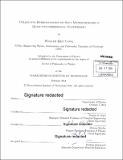| dc.description.abstract | Flow of microparticles through geometrically confined spaces is a core element of most microfluidic technologies. Flowing particles are typically ordered and manipulated with external forces or coflowing streams, but these methods can be limited in generality and scalability. New techniques to control particle trajectories would enable new applications in such areas as materials assembly, optofluidics, and miniaturized "on-chip" bioassays and cytometry. Recently, researchers have sought to understand the conditions under which particles can organize themselves through interactions generic to the flow of suspensions through microchannels. In particular, a particle moving through a viscous fluid will create a disturbance flow, affecting the motion of distant particles. These hydrodynamic interactions (HI) are sensitive to particle shape and the presence of confining boundaries. This sensitivity presents a powerful opportunity: particle trajectories could be "programmed" into particle morphology and channel design. These could chosen so that many-body hydrodynamic interactions drive self-organization of the desired particle motions. Even a single particle could be designed to "self-steer" to a desired position in the channel cross-section through its hydrodynamic self-interaction. In this thesis, we present a series of studies exploring new possibilities for achieving selforganization, self-steering, and other flow-driven collective phenomena via design of particle shape and channel geometry. We focus on a particular setting: quasi-two-dimensional (q2D) confinement, in which particles are tightly "sandwiched" between parallel plates, free to move in only two dimensions. In this confinement regime, hydrodynamic interactions take a unique dipolar form. This form had been shown to sustain novel collective phenomena with much greater spatiotemporal coherence than can be achieved in unconfined or weakly confined suspensions. However, self-organization of q2D suspensions had not been demonstrated prior to our studies. Starting from a two-body problem, we progressively consider larger numbers of particles and more complex particle shapes. In our first study, we develop model equations for the coupled motion of two discs in a quasi-two-dimensional channel. Numerically, we find that a pair can form a hydrodynamic bound state with complex oscillatory motion. We demonstrate that this "quasiparticle" can be manipulated via patterning of confining boundaries. In the following study, we consider larger clusters of discs. We provide symmetry principles for the a priori construction of "flowing crystals": configurations of particles that maintain their relative positions as they are carried by the flow. The crystalline states generalize the two-body bound state to more complex configurations and collective modes. We also consider the wider dynamical landscape, finding metastable states with new, exquisitely coordinated particle motions. However, neither flowing crystals nor metastable states spontaneously form from a disordered configuration of discs. In pursuit of self-steering and self-organization, we turn to particle shape, and study the dynamics of a single "dumbbell" comprising two connected discs. We find that a fore-aft asymmetric dumbbell will reliably align with the flow and focus to the channel centerline. In contrast, a symmetric particle will oscillate between the channel side walls indefinitely. Through theoretical arguments, we isolate three viscous hydrodynamic mechanisms that together produce self-steering, and which generically occur for asymmetric particles in q2D. We carry out experiments with Continuous Flow Lithography (CFL), finding qualitative and semi-quantitative agreement with our theoretical predictions. Obtaining statistics from hundreds of particle trajectories, we provide a convincing experimental demonstration of self-steering for device applications. To our knowledge, this study provides the first demonstration that rigid particles can focus to the centerline in a channel flow. This progression culminates in our final study. Inspired by the mobility formalism of polymer dynamics, we develop a theoretical and numerical framework that can recover the collective dynamics of many particles with complex shape. We find that small clusters of dumbbells can self-organize from disorder into one-dimensional flowing crystals. However, dumbbells can also pair as undesirable "defects." This two-body effect frustrates self-organization in large suspensions of dumbbells, driving formation of particle aggregates. To tame this aggregation, we rationally redesign particle shape, tailoring hydrodynamic interactions to promote chaining of particles in the flow direction. The redesigned "trumbbell" particles self-organize into large, two-dimensional flowing crystals. We reveal how crystal self-organization occurs through a multistage process. One, two, several, and finally many-body interactions become implicated in successive stages. This study is the first to demonstrate that flowing lattices can be stabilized purely by viscous hydrodynamic interactions. | en_US |
